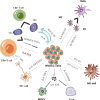Advances in tumor immune microenvironment of head and neck squamous cell carcinoma: A review of literature
- PMID: 38428879
- PMCID: PMC10906580
- DOI: 10.1097/MD.0000000000037387
Advances in tumor immune microenvironment of head and neck squamous cell carcinoma: A review of literature
Abstract
Squamous cell carcinoma is seen as principal malignancy of head and neck. Tumor immune microenvironment plays a vital role in the occurrence, development and treatment of head and neck squamous cell carcinoma (HNSCC). The effect of immunotherapy, in particular, is closely related to tumor immune microenvironment. This review searched for high-quality literature included within PubMed, Web of Science, and Scopus using the keywords "head and neck cancers," "tumor microenvironment" and "immunotherapy," with the view to summarizing the characteristics of HNSCC immune microenvironment and how various subsets of immune cells promote tumorigenesis. At the same time, based on the favorable prospects of immunotherapy having been shown currently, the study is committed to pinpointing the latest progress of HNSCC immunotherapy, which is of great significance in not only further guiding the diagnosis and treatment of HNSCC, but also conducting its prognostic judgement.
Copyright © 2024 the Author(s). Published by Wolters Kluwer Health, Inc.
Conflict of interest statement
The authors have no conflicts of interest to disclose.
Figures


Similar articles
-
Immune microenvironment of human papillomavirus-positive head and neck squamous cell carcinoma.Sci Prog. 2024 Jan-Mar;107(1):368504241237888. doi: 10.1177/00368504241237888. Sci Prog. 2024. PMID: 38545800 Free PMC article. Review.
-
Comprehensive investigation into the influence of glycosylation on head and neck squamous cell carcinoma and development of a prognostic model for risk assessment and anticipating immunotherapy.Front Immunol. 2024 Mar 18;15:1364082. doi: 10.3389/fimmu.2024.1364082. eCollection 2024. Front Immunol. 2024. PMID: 38562924 Free PMC article.
-
Tertiary lymphoid structures in head and neck squamous cell carcinoma (Review).Oncol Rep. 2025 Jul;54(1):76. doi: 10.3892/or.2025.8909. Epub 2025 May 9. Oncol Rep. 2025. PMID: 40341409 Review.
-
Comprehensive characterization of the tumor microenvironment for assessing immunotherapy outcome in patients with head and neck squamous cell carcinoma.Aging (Albany NY). 2020 Nov 18;12(22):22509-22526. doi: 10.18632/aging.103460. Epub 2020 Nov 18. Aging (Albany NY). 2020. PMID: 33216727 Free PMC article.
-
Identification and validation of a prognostic signature of autophagy, apoptosis and pyroptosis-related genes for head and neck squamous cell carcinoma: to imply therapeutic choices of HPV negative patients.Front Immunol. 2023 Jan 10;13:1100417. doi: 10.3389/fimmu.2022.1100417. eCollection 2022. Front Immunol. 2023. PMID: 36703967 Free PMC article.
Cited by
-
Effect of group management on disease cognition and fear of disease progression, nutritional status, and quality of life in patients with head and neck tumors.Am J Transl Res. 2024 Dec 15;16(12):7937-7947. doi: 10.62347/CBKG3767. eCollection 2024. Am J Transl Res. 2024. PMID: 39822501 Free PMC article.
-
A novel mast cell marker gene-related prognostic signature to predict prognosis and reveal the immune landscape in head and neck squamous cell carcinoma.Front Immunol. 2025 Jul 9;16:1538641. doi: 10.3389/fimmu.2025.1538641. eCollection 2025. Front Immunol. 2025. PMID: 40703522 Free PMC article.
-
Multi-omics and machine learning-driven CD8+ T cell heterogeneity score for head and neck squamous cell carcinoma.Mol Ther Nucleic Acids. 2024 Dec 5;36(1):102413. doi: 10.1016/j.omtn.2024.102413. eCollection 2025 Mar 11. Mol Ther Nucleic Acids. 2024. PMID: 40027882 Free PMC article.
-
Advances and challenges in immunotherapy in head and neck cancer.Front Immunol. 2025 Jun 6;16:1596583. doi: 10.3389/fimmu.2025.1596583. eCollection 2025. Front Immunol. 2025. PMID: 40547025 Free PMC article. Review.
References
-
- Sung H, Ferlay J, Siegel RL, et al. . Global Cancer statistics 2020: GLOBOCAN estimates of incidence and mortality worldwide for 36 cancers in 185 countries. CA Cancer J Clin. 2021;71:209–49. - PubMed
-
- Cramer JD, Burtness B, Le QT, et al. . The changing therapeutic landscape of head and neck cancer. Nat Rev Clin Oncol. 2019;16:669–83. - PubMed
-
- Chow LQM. Head and neck cancer. N Engl J Med. 2020;382:60–72. - PubMed
Publication types
MeSH terms
LinkOut - more resources
Full Text Sources
Medical

